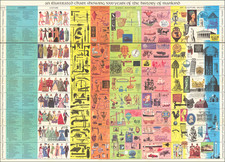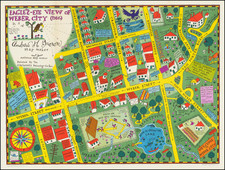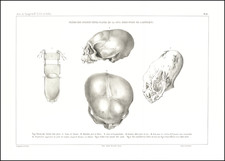A fascinating cartographic curiosity, which appeared in Protestant theologian Heinrich Bunting's Itinerarium Sacra Scripturae, or Travels According to the Scriptures, first published in 1581. The work contained three maps of pure fantasy: the World in the form of a cloverleaf, Europe as a robed female figure, and Asia as Pegasus, the mythical winged horse. The horse is drawn in an anatomically correct fashion, such that the shape of Asia has been modified, with the Caspian Sea appearing horizontally between the wings and the saddle, and modern India is the off hind leg. The image of Asia as Pegasus derives from the story of Bellerophan, his rider, which took place largely in Asia.
Henrich Bunting was a Protestant theologian and teacher born in Hanover, in what is now Germany. He attended the University of Wittenberg and graduated in 1569. He then began work as a preacher but caused some controversy with his teachings; he was dismissed from appointments in both Lemgo and Goslar.
He is best known today for his book, Itinerarium Sacrae Scripturae (Travel book through Holy Scripture), a travel collection and commentary of the geography of the Bible. The book provided the most complete summary of biblical geography then available and described the Holy Land by following the travels of various notable people from the Old and New Testaments. First published in Madgeburg in 1581, Itinerarium Sacrae Scripturae was a very popular book for the time. Over 60 editions were published between 1581 and 1757.
A particularly notable feature of the book were its many woodcut maps, many of them showing unique depictions of geographic features and continents. In addition to the conventional maps, the book also contained three figurative maps; the world depicted using a cloverleaf design (thought to possibly represent the Trinity with Jerusalem in the center), Europe in the form of a crowned and robed woman, and Asia as the winged horse Pegasus.









![[Autographs of British Admirals During the American Revolution & War of 1812]](https://storage.googleapis.com/raremaps/img/small/69274.jpg)

![(American Revolution - East Florida - Tropical Medicine - Slavery) [Manuscript document from John Moultrie dated May 16, 1784] Thoughts that may be of use to my people and plantation in the Bahamas and orders that I beg may be obeyed](https://storage.googleapis.com/raremaps/img/small/86627.jpg)
![[Gustave Eiffel's Drawings and Blueprints for the Statue of Liberty]](https://storage.googleapis.com/raremaps/img/small/58964.jpg)

